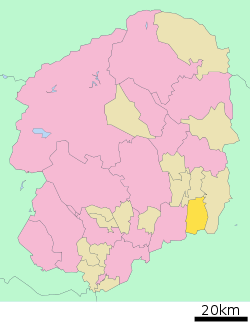Mashiko, Tochigi
| Mashiko 益子町 | |
|---|---|
| Town | |
 Location of Mashiko in Tochigi Prefecture | |
 Mashiko Location in Japan | |
| Coordinates: 36°28′N 140°06′E / 36.467°N 140.100°ECoordinates: 36°28′N 140°06′E / 36.467°N 140.100°E | |
| Country | Japan |
| Region | Kanto |
| Prefecture | Tochigi Prefecture |
| District | Haga |
| Government | |
| • Mayor | Tomoyuki Ōtsuka |
| Area | |
| • Total | 89.54 km2 (34.57 sq mi) |
| Population (October 1, 2009) | |
| • Total | 24,760 |
| • Density | 277/km2 (720/sq mi) |
| Time zone | Japan Standard Time (UTC+9) |
| Symbols | |
| - Tree | Japanese Red Pine |
| - Flower | Yamayuri (Lilium auratum) |
| - Bird | Japanese Bush Warbler |
| Address |
2030 Mashiko, Mashiko-machi, Haga-gun, Tochigi 321-4293 |
| Phone number | 0285-72-2111 |
| Website | Mashiko Town |
Mashiko (益子町 Mashiko-machi) is a town located in Haga District, Tochigi Prefecture, Japan. As of October 1, 2009, the town has an estimated population of 24,760 and a density of 277 persons per km². The total area is 89.54 km².
Culture
Mashiko is known for its pottery, called mashikoyaki (益子焼). Early pottery in Mashiko dates back to the Jōmon and Yayoi periods. Mashikoyaki is often thought of as a simple and rustic in style, brown with maybe a little red glaze,but modern pottery made in Mashiko today is found in many styles, because of the creative freedom brought to Mashiko by Shoji Hamada. Modern Mashikoyaki dates only to 1853, when a potter discovered that local clay here was ideal for ceramics. The style was popularized in 1930 when Hamada, later designated as a Living National Treasure, set up a kiln in Mashiko. Hamada′s student, Tatsuzō Shimaoka, was also designated as a Living National Treasure and worked in Mashiko from 1953 until his death in 2007.
Mashiko is a folkware kiln site that is unlike some of the other older kiln sites around Japan. The town is open to newcomers whether they be potters or others with professional backgrounds in arts, science and education. In Japan craftsmen were usually born into their profession but in Mashiko, anyone could be a potter.
There are two different types of pottery available for purchase in Mashiko. All around the center of town you will find shops selling tableware like plates, bowls and cups. There are also more specialized stores that offer artistic pieces, often, one of a kind.
Twice a year, coinciding with the Golden Week Holidays in the first week of May, and again for the first week of November, there is a pottery and crafts festival where potters and craftsmen from Mashiko and surrounds come to the town and set up stalls. A great chance to pick up some stunning pottery and other crafts including woodwork, leatherwork, glass, jewellery and textiles, and great bargains.
Recent trends
In general, the countryside in Japan has suffered major population loss since World War Two but this is not the case in Mashiko. Following Shoji Hamada, people looking to return to a more traditional Japanese lifestyle settled in the area.[1]
Places of worship
Saimyō-ji, a Buddhist temple with several important cultural relics (as designated by the national and prefectural governments), is located in Mashiko.
References
- ↑ Holmes, Ann Sommer. The Transition of the Artisan-Potter to the Artist Potter in Mashiko, a folkware kiln site in Japan. New York University Press, 1982. p. 12.
- Baekeland, Frederick. “Modern Japanese Ceramics in American Collections”. New York: Japan Society, 1993. (ISBN 0-913304-38-7)
External links
| Wikivoyage has a travel guide for Mashiko. |
- Mashiko official website (Japanese)